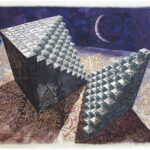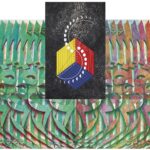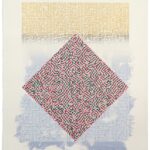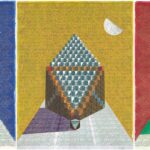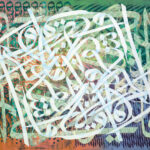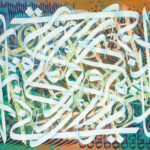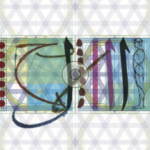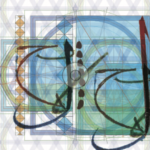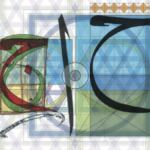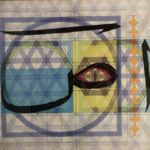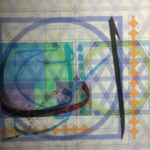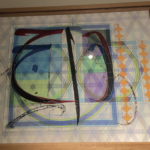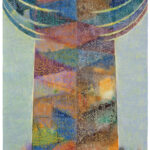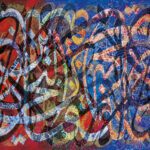Born Alexandria, Egypt, 1943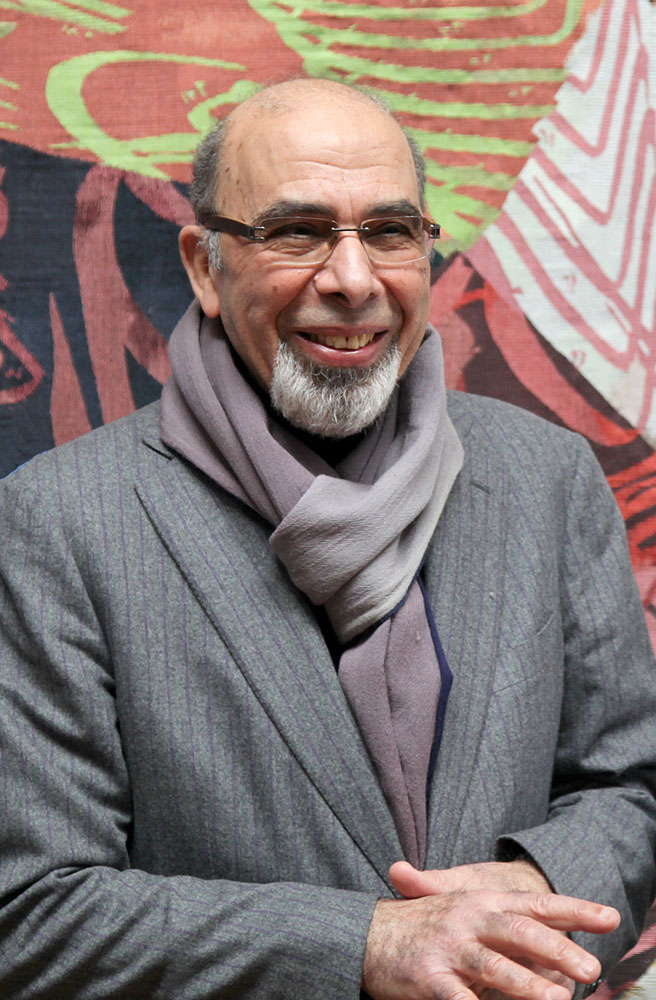
Ahmed Moustafa is an artist and scholar of international repute and a leading authority on Arabic art and design. Initially trained as a figurative artist in the neoclassical European tradition, and drawing inspiration primarily from Renaissance masters, he subsequently rediscovered his Islamic roots and his work is now almost exclusively devoted to abstract compositions inspired by texts from the Holy Qur’an. He has created an astonishingly rich visual vocabulary through an innovative fusion of skills as a painter and as a master scribe in the tradition of Arabic penmanship. Ahmed’s prodigious talent and ability to realise his vision enabled him to enter the Faculty of Fine Arts and Architecture at the Department of Painting and Stage Design of Alexandria University in 1961. He gained a BA honours degree in Fine Arts and was awarded the highest national distinction in 1966 from the University of Alexandria, where he remained as a lecturer in painting and stage design until 1973.
He won major prizes for his Occidental painting and sculpture receiving the Egyptian Festival of Education Prize, followed by 2nd Prize in Painting at the 8th Biennale of Alexandria in 1968, and First Prize in Sculpture at the 10th Biennale of Alexandria in 1973. During this period the artist also represented Egypt in most national and international exhibitions and took part in his own oneman and group shows in Cairo and Alexandria.
Moustafa has lived and worked in London since 1974 after being granted a scholarship to the United Kingdom. In 1983, he set up the Fe-Noon Ahmed Moustafa Research Centre for Arab Art and Design. His work includes lectures and workshops worldwide as well as numerous commissions among them a composition presented by Her Majesty Queen Elizabeth II to Pakistan on the occasion of this country’s fiftieth anniversary, 1997. In 1998 he was invited by the Vatican to exhibit his work at the Pontificia Universitas Gregoriana, Rome. That exhibition, entitled ‘Where Two Oceans Meet’, was heralded as the first achievement of its kind in the history of Muslim-Christian relations. In celebration of his contribution to art and culture, Muslim Power 100 awarded him its highest honour in 2007 as one of the hundred most influential Muslims in Britain.
His creative works, encompassing paintings, tapestries, silk-screen prints and stained glass, have been held in numerous major locations worldwide. The range of mediums in which his art has found expression reflects the highly creative and productive relationships he has built up with some of the finest craftsmen of Europe. His work are among the collections of international museums, institutions and private collections all over the world. In 1974, on his scholarship, he joined the print making department of the Central School of Art and Design, London, where he developed his interest in the science of Arabic penmanship and the roles of its letter shapes in the structural morphology of Islam.
In 1978 Ahmed embarked on an M. Phil research, which he completed in 1980, on a progressive investigation to provide logical and coherent explanation of the true significance of the term “proportioned script” (al Khatt al-Mansub, Ibn Muqla – 272-328AH/886-940AD). He continued to further investigate the subject and was awarded a PhD in 1989 by the Council for National Academic Awards. The research provided a definitive scientific reference for a greater understanding and appreciation of Islamic Art in general and Arabic Penmanship in particular. In fact, his work to explain the Scientific Foundation of Arabic Letter Shapes involved 11 years of painstaking research. This subject was no mean feat: the legibility of a text and the beauty of its line require rules of proportion that have never been adequately explained. No detailed study of this topic has existed in print, until now. Ahmed’s recent publication ‘The Cosmic Script’, authored jointly with Dr Stefan Sperl, senior lecturer at SOAS, London, has for the first time given a comprehensive analysis of Ibn Muqla’s theory. The key objectives include an examination of the origins of proportioned script in the cross-cultural encounter between Greek learning and the traditions of classical Islam; a demonstration of its practical application and a detailed illustration of its geometrical rules; and a reappraisal of its wider implications for the visual, as well as verbal and aural arts of Islam. Ahmed and his co-author even explore the geometrical dynamics of calligraphy – juxtaposed with the status of the pen – and their influence in classical Arabic music theory. Placed in its historical and cultural context, Arabic penmanship reveals a monumental influence in the entire artistic tradition of Islam – and beyond. Ahmed’s fresh reappraisal of the science of Arabic penmanship illuminates not only the geometric principles that underpin the visual harmony of all Islamic art and architecture at a conceptual level, but at a practical level also the terminology, practice and construction of letter shapes of the Arabic script and their variants. In fact, ‘The Cosmic Script’ is a definitive reference work on the subject.
عاش مصطفى في لندن منذ ١٩٧٤، وفي ١٩٨٣ أنشأ “فنون أحمد مصطفى” كمركز في أبحاث الفن العربي والتصميم. يتضمَّن نشاطه إعداد المحاضرات وورش العمل في أنحاء العالم بجانب قبول العمل على بعض التكليفات التي كان من ضمنها التكليف الملكي الذي نتج عنه تكوين “حيث يلتقي البحران” الذي قدمته صاحبة الجلالة الملكة إليزابيث الثانية كهدية لدولة باكستان سنة ١٩٩٧ بمناسبة الاحتفال بعيد تأسيسها الخمسين. وفي ١٩٩٨ تلقَّى دعوة من الفاتيكان لعرض أعماله في الجامعة الباباوية في روما. وحمل المعرض نفس عنوان عمل التكليف الملكي “حيث يلتقي البحران”، وانتشرت إصداء هذا المعرض في بقاع كثيرة من العالم باعتباره أول تحقيق من نوعه في تاريخ العالقات الإسلامية المسيحية. واحتفالاً بمساهمته في حقل الإبداع والثقافة، منحه الاستطلاع الذي يهدف إلى اختيار مائة شخصية مسلمة مؤثِّرة في بريطانيا (٢٠٠٧) أسمى تشريف باختياره ممثِّلاً لفئة المبدعين التشكيليِّين. وفي ٢٠١٠ منحته الجمعية الثقافية للمرأة التركية )TURKKAD( جائزة “الصديق” لدوره في خدمة الإسلام، وكان ذلك في احتفالية خاصة انعقدت في إسطنبول في اليوم المتوافق مع ميلاد الرسول الكريم محمد ﷺ. حيث تولَّى تقديم الجائزة له أعلى سلطة إسلامية في تركيا، ويمثِّلها الدكتورعلي بارداكوجلو Dr Ali Bardakoglu رئيس المنظَّمة التركية العامَّة للشؤون الدينية.
تُعَد أعمال أحمد مصطفى الإبداعية من تكوينات تصويرية أو نسجيات أو تركيبات إنشائية من ضمن مجموعات المتاحف العالمية، والمنظَّمات والمجموعات الخاصة في كثير من أنحاء العالم. وقد نشرت مقالاته
في عدد من اللغات.
Exhibition l – Naming Infinity – One Hundred Minus One
- 273 x 413 cm
- 281 x 304 cm
- 140 x 115 cm – Editions Available
- 201.5 x 160 cm each
- 220 x 80 x 80 cm
- 111.5 x 138 cm – Editions Available
- 111.5 x 138 cm – Editions Available
- 85 x 105 cm – Editions Available
- 85 x 105 cm – Editions Available
- 85 x 105 cm – Editions Available
- 85 x 105 cm – Editions Available
- 85 x 105 cm
- 85 x 105 cm – Editions Available
- 105 x 132 cm – Editions Available
- 105 x 132 cm – Editions Available

